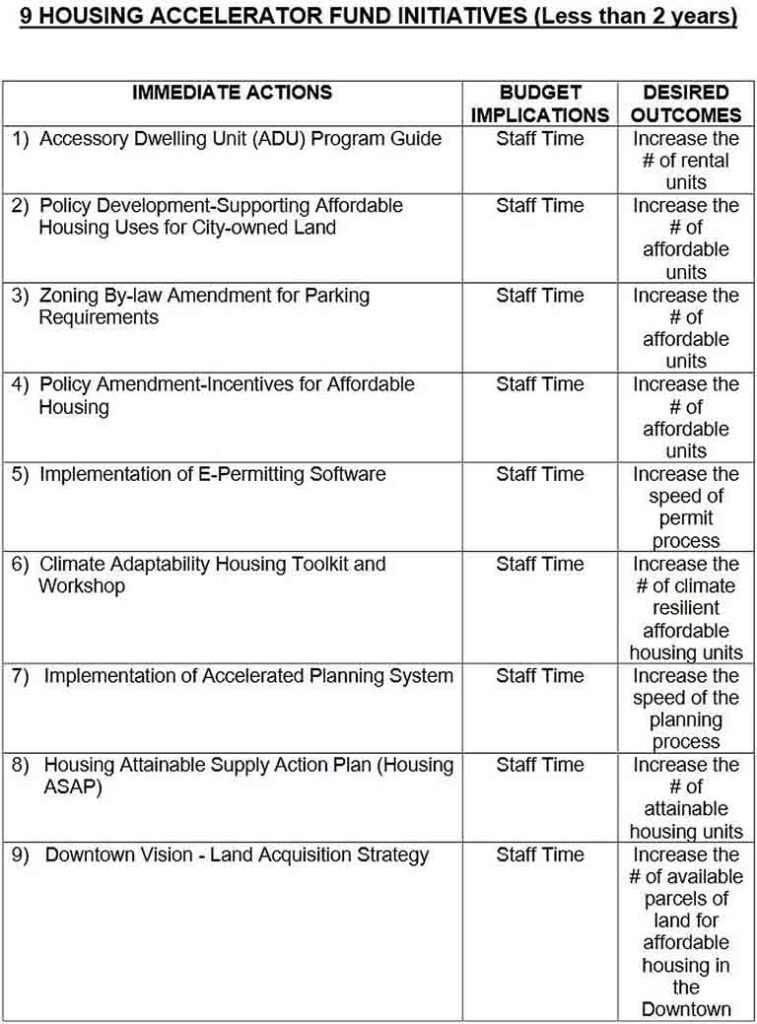Editorial: Council Preview
By John Swartz
This time, rather than run down an almost incomprehensible agenda for a council meeting and therefore almost impossible to short form it for you in a concise way, some analysis and comment is required.
It is a shining example of the sickness of the society our parents and we have built, that housing is not about living, but about banking; making money and not staying dry and warm.
Is it a wonder we have a housing crisis?
November 29, today, at 1 p.m. Orillia council has a special meeting at the Opera House to discuss one subject – housing. There are only two items on the agenda, a report from the County of Simcoe, and one from staff. The first is 28 pages long, the other 48.
The county is sending a manager and a director (Mina Fayez-Bahgat and Wendy Hembruff) to tell council about the county’s housing program. Why? In the wisdom of the Ontario government counties are the primary level of government where housing issues are decided. It’s where the money goes first to be dispensed to municipalities and on to developers and then the homeless.
The first thing standing out is the terminology (never mind in both documents the terminology seems to be designed to obscure exactly what government intends to do, which at the conclusion seems to be employment – not for the homeless, and a hook provided for politicians to hang hats on). The top of the list of terms, euphemisms, that hides the set of real problems is the word homelessness.
A person living out of their car or a tent at the back of a parking lot or in a park has a home. They made their home where they could. A home is an emotional construct. A house has nails, drywall, roofing shingles, toilets, running water and electricity.
We have a houselessness problem. But that’s more of a tongue twister to say. Yes, they are similar at face value, but in the end, homelessness changes how we think of the problem. This is no more evident than reading the reports and trying to get meaning out of them, because very few words in them refer to building houses.
One gets the sense if the bureaucrats just roll up their sleeves and get to work, something will get done. It is they and not the bricklayers, carpenters, plumbers, roofers and etc. who will solve this problem.
This is not a skewed perception taken through political goggles.

Of the nine priorities City staff earmark for how to spend $15 million they believe the city will get from a new federal housing accelerator fund, all are about policy, plans and programs. Not one is about spending money and not one is about plumbers – that is building houses.
Nine is a number we’ll get back to in a moment.
The City expects to get a favourable outcome from their grant application by, “late Fall 2023,” of which the last chance for that is only 21 days away. The quote highlights another problem with the report. All through it one finds capitalizations where none are necessary. Bureaucrats do this. Maybe it makes their typing look more impressive. They have also found a new word, within, to bandy about (of late it’s used like salt at the table). Most times using the word is unnecessary, and the rest of the time they mean in. But it’s an impressively bigger word to use.
The County’s report is made up entirely of a Powerpoint presentation. The text appears to be generated by ChatGPT with the parameters of few two-syllable words and as many 4, 5 and 6 syllable words as possible. There are entire sentences, phrases and titles which make no sense, with only the context providing clues.
Then there are many spectacularly crafted graphs. They look to be generated by monkeys who had no instructions about what to illustrate. Some graphs try to pack so much information into one page they can’t be read except with a 20x power glass. Others are presented with so little or no explanation they look to be in place as filler. The City report has the same. They are colourfully pretty though.
If one tries to make sense of the math involved with some of charts and tables, one discovers math was not often involved.
It’s telling the most informative and accurate illustration showing both the problem and the solution offered by bureaucrats in the presentation is:

One point of the City’s report, made over several pages, first surfaces with, “There are no housing types with average prices that are affordable to households below the 9th income decile ($176,713 gross annual income).”
Last time I checked a decile means 10. Why 9? Everything we know about how to parse numerical division is about 2s, 4s, 6s, 8s and 10s, with the occasional dozen for good measure. We can glance at a table and estimate percentages and make divisions, quickly with what we are familiar. Figuring out how 9 breaks down to what we instinctively understand takes calories and time. We give up and skip over the data because it’s not relatable.
Maybe it’s because it’s the 10th division is so rich, housing is of no concern –except for how much money they can make from someone else’s housing condition.
The City staff report recommended motion is:
“THAT the 2023 Orillia Affordable Housing Action Plan be received in principle as set out in Schedule “A” to this report;
AND THAT funding requirements associated with implementing the Orillia 2023 Affordable Housing Action Plan be referred to the 2025 Budget deliberations.”
Which means, give us permission to keep working and employed on this issue, and punt decisions about how to do any real spending to 2025. It’s very meaningful to the people in tents or using warming centers.
At least City staff recognize one very important thing:
“the City’s proposed 2023 Affordable Housing Action Plan is focused on providing and increasing the housing options for the moderate-income households who cannot afford current market rentals and/or home sale prices but they do not qualify for the County services.”
They at least get we live in a country where the middle class, of which most of us come from, can no longer afford rent, let alone buy a house to raise a family in. Staff also offers up this gem:
“There is no single remedy that will solve the shortage of affordable housing and solving this issue will take several years.”
This true if one is trying to justify all the paper shuffling and graph making and not trying to present arguments to build houses. What is observable about bureaucratic thinking is the amount of time used, by both local governments, to justify getting money to those who truly need it most – the developers and large property owners.
To illustrate how lofty (maybe screwed up) bureaucratic thinking is, someone, somewhere, came up with this term, concierge, used in the 18th point of the City’s affordable housing action plan (which council will effectively approve in principal toady) – “Develop a Council-approved policy to pilot a Concierge Housing Service for qualifying affordable housing developments with the goal of streamlining and assisting eligible housing providers through the municipal approvals process from start to finish at an accelerated pace.”
We all know in some way what a concierge is; all the swanky hotels have one or more. That a bureaucrat would think dropping this term into the mix – for affordable housing – as innovative thinking shows how they view the whole subject. Every morning Frank, putting his shoulder into the frozen car door to get out of his home, in order to cross the parking lot to Timmy’s to warm up thinks, “I wish I had a concierge.”
It’s a nice thought asking someone, a concierge, be designated to put the fire to approvals for developers to build houses in short order (this will surely involve hiring another staffer). But, shouldn’t everyone in the planning department be working on helping all developers (and residents trying to make additions or upgrade their houses) – as a course of business? Shouldn’t it be part of the job to help people negotiate the many rules and forms regardless of what it is they need a permit for? Sadly it is not. The main function is to tell people more paperwork is needed, or you can’t do that.
To be fair to the County has a number of grant and subsidy programs to help people pay rent, or renovate properties into livable places. They do spend this money. The point of consternation is, there could be more money for those things if the middlemen, bureaucrats, were limited in number. You should know, the City of Orillia sends $2.9 million to the County annually for housing, which means someone in Midhurst makes decisions for the City and the people needing help.
Sure, the County has a large housing project on West Street, which if one really looks at it, is architecturally not much different in appearance than the Fulton County Jail in Atlanta; not much about it says home. The only thing missing is the barb wire fencing surrounding the property.
And to be fair City staff are unfairly in the position of trying to analyze and recommend, but it’s from the perspective of their 6-figure jobs, which is to say, they overlook what people who are houseless see and know.
Also to be fair, our councillors, a good number of them, are very concerned and earnest in trying to do something. The problem is they are relying on bureaucrats to do the analysis and there is so much wordsmithing and reporting on the subject available it’s too difficult for any one councillor to make sense of or see through the smoke and recognize real solutions.
Behind all the smoke is this; the subject is being made a municipal problem. It is not. There is precious little a local council can do, but we expect them to be doing something, so we get 75 page agendas which in the end don’t put one nail into a piece of wood.
Policy and regulation at the provincial and federal level, (or more accurately, lack of) created this mess. And don’t be so quick to point at zoning and official plans as the boogieman; those things exist for real, practical reasons, but it’s convenient for Doug Ford to replicate a microphone stand and lay blame on municipalities and zoning for the dirth of house building. It is convenient for Pierre to blame Trudeau, when he knows very well the federal government has such a small role in local decisions of all kinds, including housing, it is limited to opening a chequebook.
Where were those people when Airbnb was allowed to operate in Canada. This one company bears responsibility for the jacked up rents everyone is facing. What landlord is going to say no to $2500 a week income against $1900 a month?
Where were these people when regulations and law were crafted allowing companies like Blackrock and Blackstone to out bid house buyers and gobble up entire neighbourhoods at inflated prices – with other people’s money (they are investment companies) – in order to turn them from houses in which people raised families, or hope to spend retirement years, into expensive (have to pay those dividends) rentals.
Those three companies alone are driving the price crisis in housing, and yet, there are no papers, reports, or recommendations anywhere to address them.
The housing problem is entirely the fault of bureaucrats in Ottawa and Toronto who don’t listen to you or me, but to already wealthy investors and developers, and politicians who trust their bureaucrats to recommend what is best for all.
Councillors, the thing you need to keep top of mind about your session today is, where are the bricks in all this?
You can attend the meeting, or watch it on the City’s Youtube channel.
(Photos by Swartz – SUNonline/Orillia; Images Supplied)




